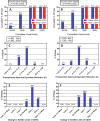Long-term visual quality after small incision lenticule extraction (SMILE) and laser assisted subepithelial keratomileusis (LASEK) for low myopia
- PMID: 35978275
- PMCID: PMC9386982
- DOI: 10.1186/s12886-022-02568-8
Long-term visual quality after small incision lenticule extraction (SMILE) and laser assisted subepithelial keratomileusis (LASEK) for low myopia
Abstract
Background: Few studies have reported the visual outcomes of small-incision lenticule extraction (SMILE) and laser-assisted subepithelial keratomileusis (LASEK) for myopia correction. This study aims to compare the visual quality and corneal wavefront aberrations after SMILE and LASEK for low-myopia correction.
Methods: In this prospective study, we included 29 eyes of 29 patients who received SMILE and 23 eyes of 23 patients who received LASEK between June 2018 and January 2019. The following measurements were assessed: uncorrected (UDVA) and corrected (CDVA) distance visual acuity, manifest refraction, corneal wavefront aberrations, and subjective visual quality. All patients were followed up for two years.
Results: All procedures were uneventful. An efficacy index of 1.19 ± 0.17 was established in the SMILE group and 1.23 ± 0.20 in the LASEK group. No eyes lost more than two lines of CDVA. We found that 93% (27/29) of the treated eyes in the SMILE group and 91% (21/23) in the LASEK group had spherical equivalent (SE) within ± 0.25D. The increases in the total corneal spherical aberration and the corneal front spherical aberration were lower in the SMILE group than in the LASEK group (P < 0.01). In contrast, the increases in the total corneal vertical coma and the corneal front vertical coma in the SMILE group were greater than those in the LASEK group (P < 0.01).
Conclusion: Both SMILE and LASEK have good safety, stability, and patient-reported satisfaction for low myopia. SMILE induced less corneal spherical aberration but greater vertical coma than LASEK.
Keywords: Laser assisted subepithelial keratomileusis (LASEK); Myopia; Small incision lenticule extraction (SMILE); Visual quality.
© 2022. The Author(s).
Conflict of interest statement
The authors declare that they have no competing interests.
Figures





Similar articles
-
Comparative study of wave-front aberration and corneal Asphericity after SMILE and LASEK for myopia: a short and long term study.BMC Ophthalmol. 2019 Mar 20;19(1):80. doi: 10.1186/s12886-019-1084-3. BMC Ophthalmol. 2019. PMID: 30894159 Free PMC article.
-
Comparison of Corneal Densitometry and Visual Quality after Small Incision Lenticule Extraction (SMILE) and Laser Epithelial Keratomileusis (LASEK): One-Year Comparative Study.Biomed Res Int. 2023 Feb 2;2023:3430742. doi: 10.1155/2023/3430742. eCollection 2023. Biomed Res Int. 2023. PMID: 36778055 Free PMC article.
-
Comparison of Visual Quality After SMILE and LASEK for Mild to Moderate Myopia.J Refract Surg. 2015 Dec;31(12):795-800. doi: 10.3928/1081597X-20151111-02. J Refract Surg. 2015. PMID: 26653723
-
Small Incision Lenticule Extraction (SMILE) and Laser in Situ Keratomileusis (LASIK) Used to Treat Myopia and Myopic Astigmatism: A Systematic Review and Meta-analysis of Randomized Clinical Trials.Semin Ophthalmol. 2023 Apr;38(3):283-293. doi: 10.1080/08820538.2022.2107399. Epub 2022 Jul 31. Semin Ophthalmol. 2023. PMID: 35912896
-
Clinical outcomes and higher order aberrations of wavefront-guided LASIK versus SMILE for correction of myopia: A systemic review and meta-analysis.Acta Ophthalmol. 2023 Sep;101(6):606-618. doi: 10.1111/aos.15638. Epub 2023 Feb 1. Acta Ophthalmol. 2023. PMID: 36726315
Cited by
-
Comparative analysis of myopia correction outcomes and aberration changes between PRK and SMILE: A study based on strict refractive criteria.BMC Ophthalmol. 2025 Mar 12;25(1):124. doi: 10.1186/s12886-025-03943-x. BMC Ophthalmol. 2025. PMID: 40075391 Free PMC article.
-
Posterior lenticule laser scan influence the ultra-early postoperative visual acuity and quality of SMILE.Sci Rep. 2024 Nov 7;14(1):27072. doi: 10.1038/s41598-024-78080-4. Sci Rep. 2024. PMID: 39511370 Free PMC article.
-
One-stage versus two-stage bilateral implantable collamer lens implantation: a comparison of efficacy and safety.Sci Rep. 2024 Mar 7;14(1):5648. doi: 10.1038/s41598-024-54101-0. Sci Rep. 2024. PMID: 38453996 Free PMC article.
-
Ten-year evaluation on efficacy, safety, and predictability of femtosecond laser corneal small incision lenticule extraction for correction of myopia and myopic astigmatism: a case series.Ann Med Surg (Lond). 2024 Sep 30;86(11):6761-6765. doi: 10.1097/MS9.0000000000002549. eCollection 2024 Nov. Ann Med Surg (Lond). 2024. PMID: 39525777 Free PMC article.
References
MeSH terms
LinkOut - more resources
Full Text Sources

